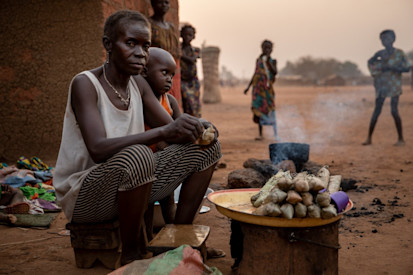
Alarm bells in the face of soaring food insecurity
The Central African Republic is a fertile country. It rains abundantly, the soil is rich and a variety of crops, fruits and vegetables grows almost year-round. Despite this apparent abundance, one in every two people does not have enough to eat.
The reason is the conflict that has again intensified since the beginning of the year. The number of internally displaced people has never been as high since 2014 as over the past months, now reaching 691,000. People live in fear of attacks and exactions by armed groups, which limits their mobility and access to fields and forests to cultivate, gather and hunt. The dangerous environment further restricts humanitarian organizations from reaching people in need. One of the results is the continued deterioration of food security since last year.
A sombre picture
Indicators projecting nutrition and food security for the lean season from April to August were already sombre but have again worsened in July.
In April, the Central African Republic reported the second highest number of people in critical food insecurity in West and Central Africa – the emergency phase, according to the global standard classification of acute food insecurity. By July, this figure had increased by 58 per cent compared to April, reaching 1 million people in critical food insecurity.
Monitoring data suggest that in July, overall 2.6 million people or 57 per cent of the Central African population did not have enough to eat. Of the 1 million people in an emergency situation concerning their food consumption, 250,000 were on the brink of famine. And to make the situation even worse, these people were largely inaccessible to humanitarian workers.
An urgent appeal
The Food Security Cluster, that unites humanitarian actors working in the sector, is sounding the alarm bells in the face of soaring food insecurity and malnutrition in the Central African Republic. Unless the humanitarian response is scaled up immediately, more than 2 million people will be food insecure by September; of them, 900,000 will remain in the emergency phase and at least 250,000 will likely fall into famine.
With no end of the conflict in sight, the vast majority of conflict-affected people will continue to rely on humanitarian assistance in the coming months. Without safe, sustained and unimpeded humanitarian access to the areas of highest food insecurity, a quarter million people will slip into a food security disaster.
The food sector now urgently requires US$22.5 million to provide life-saving full ration food assistance for 3 months for the 250,000 people at the highest risk of a catastrophic food situation, including to assist those in hard-to-reach areas by air. Only half of the country’s Humanitarian Response Plan 2021 is currently funded. The lack of resources in light of the population’s soaring needs has already forced the World Food Programme (WFP) to reduce monthly food assistance to a 20-day ration.
Malnutrition among children
In July, 80,000 children below the age of 5 were at risk of severe acute malnutrition (SAM), a 29 per cent-increase since the end of 2020. The risk of SAM is particularly high for displaced children and those in locations affected by conflict, where access to food, clean water, health care and nutrition services has been severely restricted and food prices have skyrocketed. Across the country, 395,000 children younger than 5 suffer from chronic malnutrition – 40 per cent of all children in this age group, a rate considerably above the emergency threshold of 30 per cent. Inadequate nutrition over a long period of time disrupts their growth. Acute malnutrition represents a major public health problem and is one of the leading causes of morbidity and mortality in young children.
Linking access restrictions
Humanitarian monitoring systems indicate a direct link between conflict, growing access challenges and the sharp increase in food insecurity. Safe and unhindered humanitarian assistance to areas in the northwest, notably Ouham and Ouham-Pendé Prefectures, and the south-eastern Basse-Kotto, Haut-Mbomou and Mbomou Prefectures is hampered by active conflict, shifting frontlines and the presence of explosive devices. These same factors limit access to fields, the mobility of migrant herders and the supply of markets. The rainy season from April to October further restricts humanitarian organizations’ ability to deliver assistance at scale and at an affordable price by road.
What is being done
During the first half of 2021, 1.29 million people received life-saving food or nutrition assistance from humanitarian partners. But humanitarian access remains very restricted, if not impossible, in various locations in Ouham-Pendé, Haut-Mbomou, Basse-Kotto and Ouaka Prefectures.
During the current agricultural season, 60,900 food insecure households of 305,000 people are receiving urgent support to re-establish agricultural livelihoods through the distribution of seeds and tools, re-stocking of fast-maturing livestock and cash transfers.
In June, the World Bank approved a US$50 million grant to boost food production and build the resilience of food insecure smallholders and households in the Central African Republic. This financing will provide much needed support to more than 465,000 food insecure small farmers through cash-for-work activities, while rehabilitating small-scale agricultural infrastructure in six prefectures in the west and centre of the country and the capital Bangui.
Investing in long-term solutions
Humanitarian partners are also investing in more sustainable solutions for the prevention and management of malnutrition, including the promotion of nutritious foods, good feeding practices for infants, children and pregnant and breastfeeding women and multisectoral response related to the provision of quality basic social services, including water, sanitation and hygiene, health care and protection.